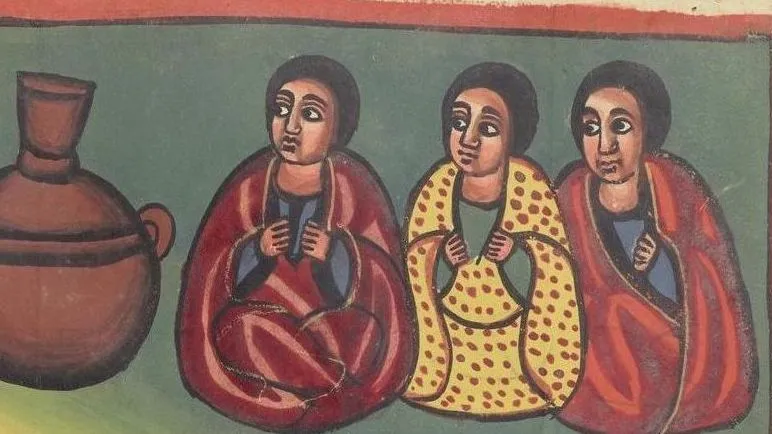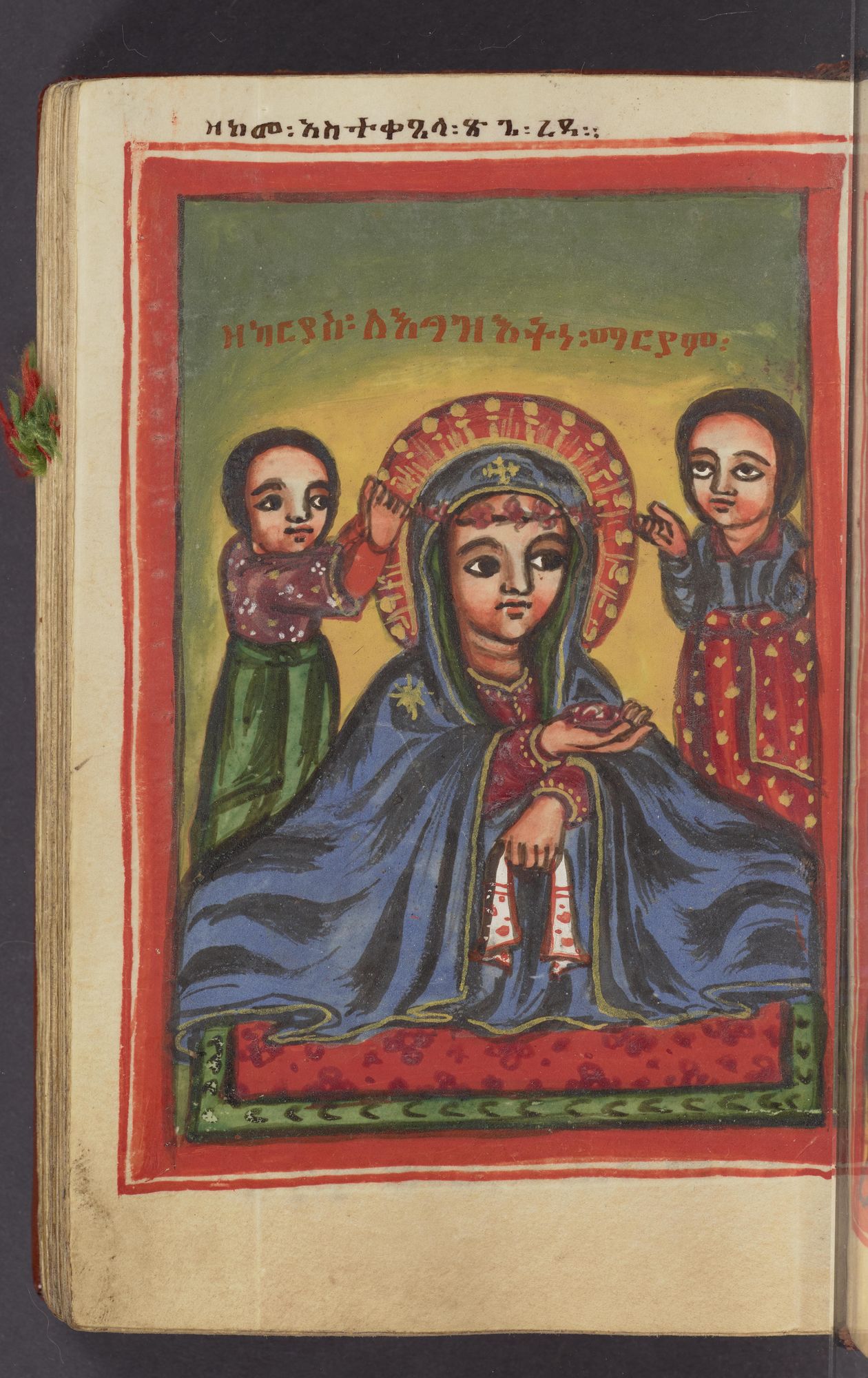PEMM Illuminates East African Manuscripts, Digitally
22 December 2020

[Author’s note: This post is part of our series on multilingual DH at the CDH. The series kicked off with our announcement that the NEH had awarded funding to“New Languages for NLP: Building Linguistic Diversity in the Digital Humanities,” which will be hosted by the CDH beginning in spring 2021.]
Six months after the Center for Digital Humanities wrapped up our two-year collaboration with the Princeton Ethiopian Miracles of Mary Project (PEMM)—or የፕሪንስተን የኢትዮጵያ ተዓምራተ ማርያም ፕሮጀክት, in Amharic—the PEMM team is hard at work building this critical resource and making it available to users.
Led by Professor Wendy Laura Belcher (Comparative Literature and African American Studies), PEMM centers on miracle stories about the Virgin Mary from Ethiopia, Eritrea, and Egypt. The stories, which date from about 1200 to 1950, are composed or preserved in Gəˁəz (classical Ethiopic) and appear in a compilation text called Täˀammərä Maryam (Miracles of [Saint] Mary). An extensive collection of Täˀammərä Maryam manuscripts is held by Princeton University Library Special Collections.
The stories appear in different versions, combinations, and orders in the manuscripts, and are often accompanied by striking illuminations depicting events and figures described therein. Because the manuscripts are dispersed and digital access to African texts is often limited, the stories have not received the scholarly attention they demand.

“While these stories constitute one of the most important medieval African archives of texts still extant, scholars can authoritatively state almost nothing about them,” explained Belcher. “How many are there? When was each written? What themes do they have? Have these African stories grown and changed across regions, languages, and periods?”
CDH’s partnership with PEMM involved the creation of a data structure to facilitate the collection of data from the stories and enable computational analysis (read the 2019–20 project charter ). In addition, CDH Lead Developer Rebecca Sutton Koeser and Digital Humanities Developer Nick Budak built an Incipit Tool that helps users identify a story by typing its incipit, or opening line, into a search field.
Koeser explained that because there are many variants of similar letters and “multiple ways to write the same sound” in Gəˁəz, and few DH projects engage with it, working with the language seemed “a bit intimidating” at first. “Fortunately, we were able to adapt a list of orthographic variants from the Beta maṣāḥǝft project, along with a list of synonyms provided by Wendy Belcher, to configure the search to work more effectively,” Koeser added. Moreover, “the characters are all included in unicode, and punctuation was recognized as such—which meant that basic things like tokenization worked the way they should.”
Currently, three PEMM affiliates at Catholic University who know the Gəˁəz language—Dr. Jeremy Brown, Mehari Worku, and Dawit Muluneh—are busy cataloging stories in manuscripts, so that enough iterations of each story have been cataloged to draw conclusions from computational analysis of them. “Cataloging stories requires deep scholarly knowledge of the Gəˁəz language and canon as well as painstaking repetitive work,” Belcher explained. “The number of people in the world who know Gəˁəz and English at this level is at most a few hundred, so we are extremely fortunate to have these three scholars working with us.”
Meanwhile, Princeton undergraduates are assigning keywords to the English translations of the stories to categorize their content, tagging and describing the illuminations, and translating stories previously translated into other European languages. Creating data on such topics as the story’s themes and characters will deepen understanding of the corpus.
Though current data is publicly available on Github, it is not ready to cite just yet. Estimates are that usable data will be ready in summer 2021, and Belcher hopes to create a new research website to share it.
Even as the project promises to be an important resource for scholars, the miracle stories are not only, or even primarily, of academic interest. At a lecture hosted by PEMM earlier this year, Getatchew Haile, Regents Professor Emeritus at Saint John’s University (Minnesota) and an expert on Gəˁəz literature, described the importance of the Virgin Mary in Ethiopian culture today.
“Mary is everywhere in Ethiopia,” he said, adding examples of different circumstances in which Ethopians often invoke Mary. For instance, when children finish playing for the day, they might say of their toy or game, “may Mary play with it,” meaning that they are giving it to Mary to play with.
Accordingly, one of the goals of PEMM is to make these important stories more accessible to the Ethiopian Orthodox Church community and for those of East African heritage, as well as to get more people interested in the literature and art of the region.
PEMM’s diverse group of contributors reflects these commitments. Project collaborators, board members, and advisers include researchers, and religious and community leaders in Africa and beyond (Haile is an advisor). Among the project’s institutional collaborators are academic centers, libraries, and research networks that promote the study of the stories and African literature more broadly.
Moreover, volunteers who know how to type fidəl—the script used in Gəˁəz, as well as commonly spoken languages like Amharic and Tigrinya—are invited to add incipits to a PEMM Google Sheet. Belcher reports that since spring 2020, volunteers have included an Ethiopian-American high school student, Ethiopian and American undergraduates and graduate students at several colleges and universities, and postdoctoral scholars from the United States, Ethiopia, Germany and Italy.
Indeed, for Belcher, the “involvement of young Black scholars collaborating from all over the world” is “one of the most exciting features of PEMM.”
Princeton students interested in learning more about the manuscripts and the Gəˁəz language will get a chance this summer, with the University offering a Gəˁəz language pilot program taught by Professor Hamza Zafer (University of Washington). Belcher notes that the pilot ”is intended to scale up teaching of the language for the full-time curriculum.”
Those who want to dig deeper can also look forward to reading Belcher’s book in progress. Ladder of Heaven: The Miracles of the Virgin Mary in Ethiopian Literature and Art is under contract with Princeton University Press.
Meanwhile, the CDH is turning the page—to a new set of African manuscripts, that is. Just as the CDH concluded the partnership with PEMM, the team kicked off our new collaboration with the Princeton Geniza Project (PGP). PGP centers on manuscripts found in the geniza chamber of a synagogue in Cairo and written in four languages: Judaeo-Arabic, Hebrew, Aramaic, and Arabic.
Sounds like 2021 will bring even more lessons in multilingual DH!
[Carousel Image: detail from an image of Mary giving water to a thirsty dog, Princeton Ethiopic Manuscript No. 65, image 199].